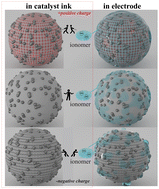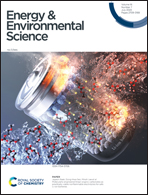Unraveling the core of fuel cell performance: engineering the ionomer/catalyst interface†
Abstract
The biggest obstacle to the widespread implementation of polymer electrolyte membrane fuel cells (PEMFCs) is their cost, primarily due to the use of platinum catalysts. The high intrinsic catalyst activity exhibited on a rotating disk electrode (RDE) is rarely realized in a membrane electrode assembly (MEA), which is a long-standing challenge for PEMFCs and a cause of low catalyst utilization. To translate the high RDE performance of a catalyst into a MEA, the design of an ideal ionomer/catalyst interface is proposed: a thin, conformal ionomer film covers the maximum surface of a Pt nanoparticle and thus simultaneously maximizes catalyst utilization, (i.e., high mass activity and electrochemically active surface area) and O2 diffusion rate (i.e., high current density performance) without compromising proton conduction. Building such an interface is a long-standing challenge due to the lack of interaction between the ionomer and catalyst particles, resulting in large ionomer agglomerates and inhomogeneous ionomer coverage over the catalyst nanoparticle, with consequent poor fuel cell performance. In this work, this ionomer/catalyst interface has been engineered, utilizing the electrostatic attraction between positively charged catalyst and negatively charged ionomer particles in a catalyst ink and preserved in a solid catalyst layer. As a result, this interface leads to previously unachieved proton exchange membrane fuel cell performance in terms of both catalyst utilization (75% vs. 45%) and peak/rated power density (i.e., 1.430/0.930 W cm−2, H2/air, cathode Pt loading: 0.1 mgPt cm−2) for pure Pt catalysts, even better than those of Pt alloy catalysts. This work demonstrates the formation of an interface in the liquid phase (using ultra-small-angle X-ray scattering in combination with cryo-TEM, isothermal–titration–calorimetry) and the preservation of the interface in the solid catalyst layer (using TEM) and estimates the effective coverage and thickness of the ionomer film (using limiting current density, RDE and fuel cell performance).



 Please wait while we load your content...
Please wait while we load your content...